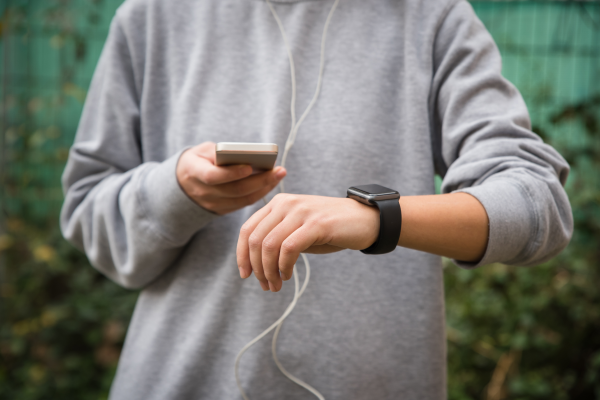6 Trends Shaping Up the Future for Wearable App Development in the Year 2022
by Smitesh Singh, on Jan 5, 2022 8:57:28 PM
Wearable technology has been impacting the mobile application development avenue, traversing a gamut of industries with its optimal and flexible support. The modern-day tech world has had a critical role in mobilizing the next-gen technologies of today, surpassing the expectations of the world on what is feasible. The prospective technology in the wearables space will have significant momentum in terms of engineering evolution with endless possibilities. According to research, 25% of the US adult population is projected to buy a wearable device by the year 2022. These devices offer multi-platform support along with numerous user-friendly functions. Let us look at some trends that will complement this momentum:
The prospective technology in the wearables space will have significant momentum in terms of engineering evolution with endless possibilities. According to research, 25% of the US adult population is projected to buy a wearable device by the year 2022. These devices offer multi-platform support along with numerous user-friendly functions. Let us look at some trends that will complement this momentum:
Internet of Things
IoT is the core of these interconnected devices. It connects devices and facilitates data exchange to calculate logical outcomes for smart living. Connectivity isn't just another branch of IoT, it is the prime feature of wearables that sell them in the first place. The future of IoT can be seen in a list of its use cases in healthcare. Here’s the list of wearable IoT devices that various healthcare institutions are launching:
- Glucose trackers
- Sports utility devices to avoid accidents and injuries
- Wearable defibrillators for heart patients
- Remote asthma monitoring
- Bluetooth enabled monitoring apps for critical patients
Apple as well as Google have retail customers as a target audience for their products like iWatch, smart lens, etc. Samsung, besides the Galaxy smartwatch, also has IoT solutions in wearables for fleet monitoring and management. Therefore, the future of IoT is strongly linked with wearables and will continue to impact app development for end-users. Wearable app developers should integrate IoT in their products in order to make a mark in the field.
Customized app functions
Wearable apps need lesser resources because their memory, as well as hardware, are lower in cost as opposed to smartphones. Consider the smartwatch app for example, while generic mobile apps can be overwhelmed with a gamut of secondary features, the smartwatch will restrict itself to the core function, which is displaying time.
Data ownership
The Internet of Things has repurposed its image as the Internet of Everything. According to research, there will be 31 billion IoT devices. Together, they will generate data worth 79 zettabytes.
The following sources of data will offer the most in this cycle:
- Business Applications
- Industrial systems
- Wearables
- Web data
- Sensors
- Digital media
- GPS tracking sensors
Wearable technology devices such as fitness trackers, smart eye-wear, and body-mounted gear create data that enables hardware and software vendors to map consumer profiles. Shared data ownership will enable the linking of wearable technology companies with e-retail & digital marketplace platforms.
e-Payments through wearables
NFC or Near Field Communication Technology connects a device to assets such as credit cards, prepaid debit cards, etc. A wearable application development company can offer you end-to-end support for these projects. This can help you create apps equipped with e-payment gateways. Users can flash their app in the smartwatch or smartphone against the terminal at a store and pay instantly.
Smartwatch development
Consumer psychology is inclined to speed. Smartwatches provide an exhaustive experience for smartphones at a far lesser price. Smartwatches can be used as fitness trackers, as an alternative to the smartphone, and more. In an age driven by quick interactions, they can instantly receive notifications from social media. Some wearable devices also come with in-built YouTube support. People who are health-conscious can monitor their sleep, level of glucose, calories burned, stress levels, and more with a smartwatch. Hence, facilitating smartwatch interface interaction with home electronics and gadgets is supposed to be the next big thing.
Beacons technology
Beacons are transmitters that function on low-power to interact with the devices that are in the proximity of a few meters. They can link up with the closest smart devices and send & receive data to enable location-based lookup. Talking about the hardware set-up, it is akin to a collection of CPUs, a couple of batteries, and a radio. Given the simple logistics of beacon devices, it is easily integrated into devices like smartwatches. A wearable application development company can predict a measurable growth of the beacon technology in the imminent future.
Conclusion
Apart from the wow-factor endowed by wearable devices, they offer people a boost in their standard of living. Contactless business activities, on-demand facilities, along with AR/VR backed immersive experience, IoT and wearables have given enterprises enough reasons to invest. Moreover, with wearable device manufacturing picking up pace, the respective app engineering will grow in demand too. To get started with wearable apps development, get in touch with a trusted technology partner.
Next Reading:
- What are AMPs and Why Enterprises Should Care?
- Mobile Concierge App for Hotels - How To Develop and Benefits
- How to Build a Reliable Waste Management and Segregation App

















